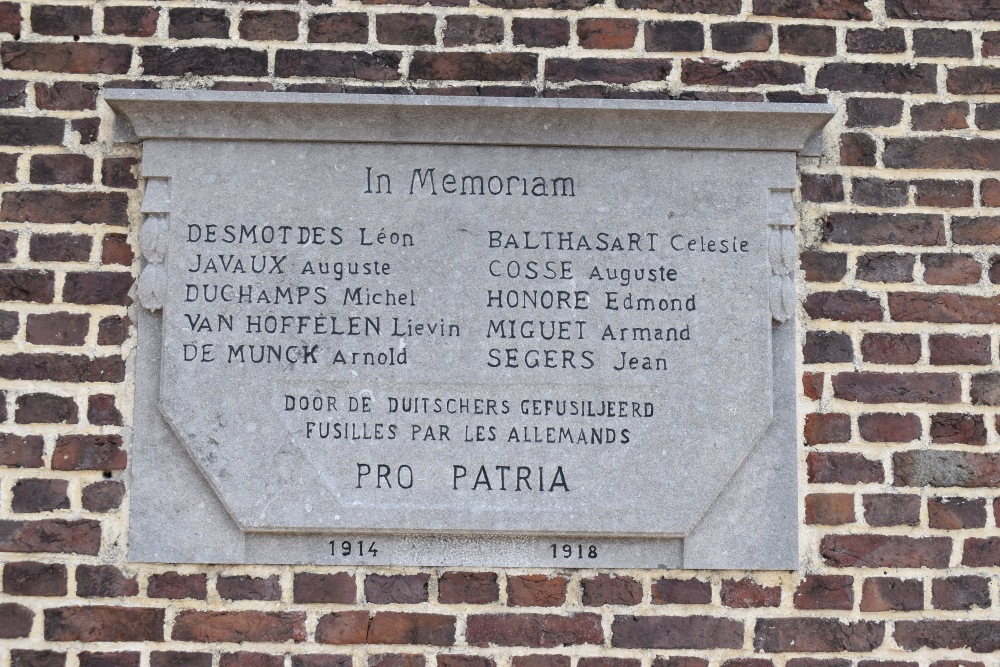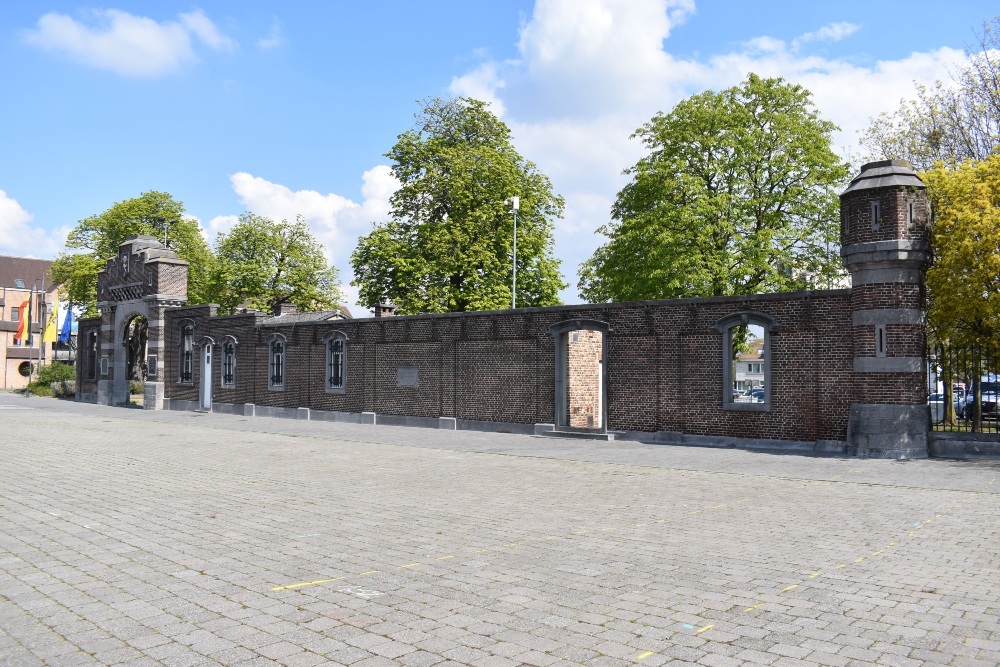Memorial Executed Victims First World War Hasselt
This is the commemorative plaque to the ten Belgian members of a spy network executed by firing squad in one single day, that being the 16th December 1916.
They were all part of what was known as the Service Bordeaux or Frankignoul network named after the Belgian agent based in Maastricht .This was run by Captain Richard Tinsley who was station chief for the British secret service bureau based in Rotterdam .He was the manager of the city's Uranium Steamship Company office, which provided both cover and the local knowledge required to operate a spy network from neutral Netherlands across eastern Belgium and north east France using British, Dutch, and Russians as well as Belgian nationals.
The primary type of intelligence came in the form of trainspotting, detailing troop and equipment movements along the rail networks .This information had to be passed on across the Belgian border with the Netherlands, which became more problematic when the electric fence or "wire of death " started to be constructed by the Germans in the spring of 1915.
The relevant Belgian network that resulted in the executions in Hasselt was first formed by Joseph Jacques in March 1915 after the soldier from the 4th Line Regiment was wounded around Liege at the beginning of the war .He flees the Liege hospital and crosses the Dutch border and meets and is recruited by Arthur Frankignoul.
Using such devices as codes, secret compartments, invisible ink and different couriers the network was successful at first .However, too many in the network knew each other and a secret compartment used on the steam tram into Maastricht became known to the German secret police .
The ten.
All went well until the 3rd of July 1916 when Leon Desmottes is arrested in Liege.He was the head of the group at the time of his arrest, taking over from Jacques in February 1916, no doubt due to his being Jacques's sergeant-major in his unit .Born on the 26th February 1876 in Chapelle-a-Wattines, he does the sections accounting, organises observation posts and couriers, and also details activity at the local Liege fortifications. He is taken to Hasselt prison the place where all the suspected spies in this part of Belgium ended up, and where ultimately he awaits his trail .His final resting place is Robermont cemetery, Liege.
The next to be arrested are Auguste Javaux and Michel Duchamps on the 29th July 1916.
Javaux was born in Liege on the 19th June 1865. A well travelled and cultured man he organises observation posts along railway lines and uses his guise as seller of religious vestments to smuggle documents in to the Netherlands. Common to many members of the group, family members would also participate in the espionage .He is assisted in his role as section leader by his wife Anna, sister Celine, son Pierre and daughter Helene, who takes over as the groups leader when Desmottes is arrested on the 3rd of July .All are imprisoned and later Helene will die while confined to hard labour .Another caught at the Javaux home when the police raid took place was Laure Chevry who was immortalised with the ten when she was included as the women in the illustration in the French Petit Journal Sunday Supplement of the 21st January 1917 of 11 being shot by a German firing squad. Although she was a courier her sentenced was commuted to a lifelong hard labour based on the idea she was only at the address by coincidence .Unfortunately, she became sick as a result of her confinement and died shortly after the war.
Michel Duchamps from Boncelles was born on the 6th September 1887.He works as a courier for the group, which includes his brother Leopold .They were both arrested, but his brother gets a sentence of hard labour.
On the 31st July Auguste Cosse was arrested .Born on the 7th March 1876 in the village of Dorinne, he becomes a chief guard on the Belgian railways.Here and from his home with his wife Zoe in Saint-Servais, Namur he is able to log train schedules twice a week and pass on the information until both he and his wife are caught .Like all the others caught they are taken to Hasselt prison and while Auguste faced the firing squad Zoe is sent to Holzminden internment camp for a year.He is also remembered in Saint-Servais cemetery, Namur on a memorial to its city's civilian hero's shot for their homeland.
The next day, the 1st August three of those to executed are arrested.
Edmond Honore born in Beaumont, in the Belgian province of Hainault on the 14th April 1874 who becomes a chief guard at Charleroi railway station.Recruited in March 1915 by Fernand Rikir an important player in the ring, he uses his house near the station assisted by his wife Anais, son Albert and daughter Sylva to observe and report train movements .His wife had already succumbed to ill health on the 19th March 1916 following the loss of a leg during an accident before the war. When the three remaining active family members are arrested and later taken to Hasselt .Edmond's two children are given 10 years hard labour .
Arnold De Munck was born on the 25th April 1877 in Gent.He becomes a chief guard on the railways and lives in Angleur, Liege, where he is recruited by Jacques .Assisted by his wife Caroline he observes and records train movements. After capture his wife gets a life sentence of hard, and he the firing squad .
Jan Segers was born on the 10th March 1889 in Kinrooi, and goes on to live in Rekem and work as a tram guide .As part of the network he hides the reports on the tram in to Maastricht .
The Germans caught up with Lievin Van Hoffelen on the 19th August 1916. He was born in Antwerp on the 19th July 1871 and goes on to work in Liege as a glazier .Moreover, his house near Liege, Guillemins station is perfect for observing train movements on the important nearby rail lines for the network, while his son Jules passes the information on. His son gets 10 years hard labour and he the firing squad.
The final two of the ten executed were both caught on the 21st August 1916.
Celeste Balthasart was born on the 15th October 1857 in Chaudfontaine .He is recruited here to observe and record train movements each day with the help of his wife Marie-Catherine and her sister Josephine .After capture his wife gets 10 years hard labour and his sister-in-law 12 years, while he is to face the firing squad.
Armand Miguet was born in Vechmaal on the 11th October 1882 . He acquires work as a tram attendant and is recruited by Jacques in to the network where he hides reports in the trams that run across the border to Maastricht.When caught he also ends up in Hasselt prison and hence to meet his end by firing squad with the other nine.
The trial takes place in Hasselt from the middle of November 2016 for 55 members of the group, however as Fernand Rikir manages to flee, cross the border and re-join the frontline he is found guilty of death in abstentia .Five accused are released, and those not among the ten facing execution are all to serve hard labour .The "Frankignoul disaster" deprives the Allies of important intelligence regarding German forces movements to and from the front including Verdun.
On the morning of the 16th December 1916 around 7am the ten condemned men are shoot in two groups of five by firing squad in the courtyard of Dusart barracks.
On Wednesday the 22nd October 1919 the bodies were exhumed and then identified .
After which they were solemnly commemorated, with military honours and a remembrance cathedral service with a gun carriage parade with floral tributes witnessed by large crowds paying their respects.
In August 1927 the ten executed at Dusart barracks and their counterparts executed in the nearby Herkenrode barracks were to have plaques in their memory initiated .The unveiling of these memorials were witnessed by the governor of Limburg, (Theodore) the Count de Renesse, the mayor of Hasselt Ferdinand Portman, councils members, the commanding officer of the 11th Line Regiment Colonel Cresens, the chairman of Pro Patria Mr Van Weddingen, and the cleric who gave the condemned their last rites, Vicar Demeer.
Do you have more information about this location? Inform us!
Source
- Text: Ian Paterson
- Photos: Ian Paterson
- https://www.maisondusouvenir.be/auguste_javaux.php
- http://wo1.grootheers.be/Vechmaal-Miguet_Jean_Armand_-verhaal_Hasselt-.pdf
- MI6: The history of the Secret Intelligence Services 1909-1949 by Keith Jeffery
- Spynest: British and German Espionage from Neutral Holland 1914-1918 by Ewin Ruis
Nearby
Point of interest
- American 203mm Howitzer M1A1 Hasselt - Hasselt
- Ruins Bombed Church - Hasselt
- Bomb Craters Hasselt Railway Station - Hasselt
Monument
- Memorials Colonel Dusart - Hasselt
- Provincial Memorial for Limburgers Died For The Fatherland - Hasselt
- Memorial Members Secret Army - Hasselt
Cemetery
- Belgian War Graves Hasselt Old Cemetery - Hasselt
- Belgian War Graves Hasselt Communal Cemetery - Hasselt
- Commonwealth War Graves Hasselt - Hasselt
Fortification
- Diepenbeek Lock Bunker D1 - Diepenbeek
- Diepenbeek Lock Bunker D2 - Diepenbeek
- Diepenbeek Lock Bunker D3 - Diepenbeek






